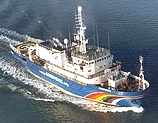|
The
Greenpeace fleet of ships plays an important role within the
organisation. They are used at the forefront of Greenpeace
campaigning, often sailing to remote areas to bear witness and
take action against environmental destruction.
GREENPEACE SITE INDEX
GREENPEACE WORLD LINKS
GREENPEACE SHIPS
|
 |
The
Motor Vessel Esperanza |
Launched
in February 2002, the Esperanza is the latest and
largest vessel in the Greenpeace fleet, replacing
the now retired MV Greenpeace. Esperanza (Spanish
for "hope") is the first Greenpeace ship
to be named by visitors to our web site.
The ship is the fourth of 14 fire-fighting vessels
ordered by the Russian government between 1983 and
1987 from Stocznia Polnocna construction yard in
Gdansk, Poland. Heavy ice class and speed were one
of the requirements.
|
 |
The
Sailing Vessel Rainbow Warrior |
The
SV Rainbow Warrior is perhaps the most famous
Greenpeace ship due to its predecessor sinking in
New Zealand in 1985 after a French Secret Service
agent planted two bombs on the ship.
The ship's name was inspired by a North American
Indian prophecy that influenced the crew on board
the Phyllis Cormack, during the first Greenpeace
voyage.
|
 |
The
Motor Vessel Arctic Sunrise |
Ironically,
before Greenpeace owned the MV Arctic Sunrise it
was once a sealing vessel. Greenpeace also had
previously confronted the ship while it was
delivering equipment for the French government to
build an airstrip through a penguin habitat in the
Antarctic.
Despite this, Greenpeace bought the Arctic Sunrise
in 1995 using a company called Arctic Sunrise
Ventures Ltd, since the ship's Norwegian owners
would never sell it to Greenpeace.
|
 |
The
Motor Vessel Argus |
The
Argus is Greenpeace's smallest motor-ship and
mostly works in the Rotterdam (the Netherlands)
harbour or along the North sea coast.
In Greek mythology Argus is a giant man with eyes
all over his body so he can watch everything very
closely. This is symbolic of the Greenpeace Argus
ship, which closely monitors pollution.
|
 |
The
Greenpeace balloon |
| The
Greenpeace balloon can carry three people, a pilot
+ two passengers, usually a campaigner and
photographer or parachutist. Three more people are
needed to form the ground crew.
Historic Greenpeace balloon flights include
flights over the Berlin wall in 1983, over the US
Nevada nuclear test site in 1987 and over the Taj
Mahal during the nuclear testing protest in India
in 1998. |
|
MORE
ABOUT THE GREENPEACE BALLOON
The balloon can only be launched in low winds (up to 10 knots).
In many parts of the world, this means it can only be flown two
hours after sunrise and two hours before sunset. This is
because during the day the sun heats up the atmosphere and
creates thermals that make balloon flying dangerous. In
winter months, when the sun's heat is less powerful, there is a
better chance of making daytime flights. The balloon
can stay airborne for a maximum of two hours in normal
conditions (a cool temperature under 2000 metres above sea
level).
There
are two types of balloon flight - free or tethered. During
free flights, once launched the balloon is carried in the
general direction of the wind. The pilot can steer the
balloon to an extent by taking advantage of different wind
directions at higher and lower altitudes. For tethered
flights the wind speed must be less than for free flights (about
8 knots maximum), because the balloon is in effect resisting the
wind and the hot air could be blown out of it, causing it to
sink rapidly.
|